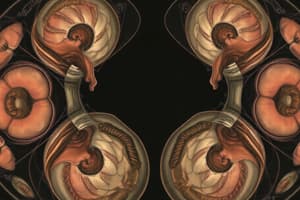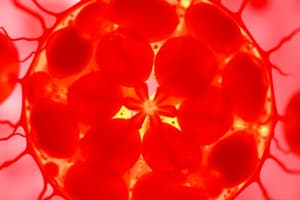Podcast
Questions and Answers
What marks the transition from prophase to prometaphase?
What marks the transition from prophase to prometaphase?
- Formation of the metaphase plate
- Disintegration of the nuclear envelope (correct)
- Splitting of sister chromatids
- Initiation of cytokinesis
What occurs during metaphase that is essential for proper chromosome segregation?
What occurs during metaphase that is essential for proper chromosome segregation?
- Chromosomes are replicated
- Microtubules attach to kinetochores (correct)
- Sister chromatids separate
- Nuclear envelope reforms
Which event characterizes anaphase?
Which event characterizes anaphase?
- Completion of cytokinesis
- Separation of sister chromatids (correct)
- Disappearance of the nuclear envelope
- Formation of the nucleolus
During telophase, which structure starts to reform around the clustered chromosomes?
During telophase, which structure starts to reform around the clustered chromosomes?
What is the primary difference between meiosis I and meiosis II?
What is the primary difference between meiosis I and meiosis II?
What is a key feature during cytokinesis following mitosis?
What is a key feature during cytokinesis following mitosis?
What structures allow microtubules to pull chromosomes during mitosis?
What structures allow microtubules to pull chromosomes during mitosis?
What role do spindle fibers play during mitosis?
What role do spindle fibers play during mitosis?
Which phase of the cell cycle is responsible for DNA synthesis?
Which phase of the cell cycle is responsible for DNA synthesis?
What occurs during the prophase stage of mitosis?
What occurs during the prophase stage of mitosis?
How many daughter cells are produced at the end of mitosis?
How many daughter cells are produced at the end of mitosis?
What is the main purpose of interphase in the cell cycle?
What is the main purpose of interphase in the cell cycle?
During which phase do chromatids form the compact mitotic chromosomes?
During which phase do chromatids form the compact mitotic chromosomes?
What marks the end of cytokinesis?
What marks the end of cytokinesis?
Which phase follows the S phase during interphase?
Which phase follows the S phase during interphase?
What is the role of the centromere during cell division?
What is the role of the centromere during cell division?
What occurs during prophase I of meiosis that distinguishes it from prophase in mitosis?
What occurs during prophase I of meiosis that distinguishes it from prophase in mitosis?
What is the primary event that differentiates anaphase I of meiosis from anaphase in mitosis?
What is the primary event that differentiates anaphase I of meiosis from anaphase in mitosis?
What is the result of cytokinesis following telophase I in meiosis?
What is the result of cytokinesis following telophase I in meiosis?
Which event specifically allows homologous chromosomes to exchange genetic material during meiosis?
Which event specifically allows homologous chromosomes to exchange genetic material during meiosis?
What is formed at the end of meiosis I?
What is formed at the end of meiosis I?
In metaphase I of meiosis, how do the homologous chromosomes align?
In metaphase I of meiosis, how do the homologous chromosomes align?
Which structural feature characterizes homologous chromosomes?
Which structural feature characterizes homologous chromosomes?
What happens to the nuclear envelope during prophase I of meiosis?
What happens to the nuclear envelope during prophase I of meiosis?
Study Notes
Mitosis Overview
- Mitosis consists of several phases: prophase, prometaphase, metaphase, anaphase, telophase, and cytokinesis.
- Prior to mitosis, cells are in interphase, where they prepare for division by gathering nutrients and replicating DNA.
Prophase
- Marked by the assembly of the mitotic spindle, consisting of microtubules and proteins.
- The nuclear envelope disintegrates, signaling the beginning of chromosome separation.
Prometaphase
- The nuclear envelope completely breaks down, allowing microtubules to connect to kinetochores at centromeres.
- Microtubules facilitate movement of chromosomes within the cell.
Metaphase
- Chromosomes align at the metaphase plate, pulled by microtubules with equal force, to ensure an even distribution of genetic material to daughter cells.
Anaphase
- Sister chromatids are separated and become individual chromosomes.
- Chromosomes move towards opposite poles of the cell, directed by kinetochore fibers.
Telophase
- Chromosomes gather at both poles and begin decondensing into chromatin.
- The nuclear envelope reforms around each set of chromosomes, and cellular structures like Golgi bodies and nucleolus re-emerge.
Cytokinesis
- The final stage where the cytoplasm divides, resulting in two distinct daughter cells.
- Marks the completion of cell division after mitosis.
Meiosis Overview
- Meiosis includes two rounds of cell division: meiosis I and meiosis II, following a DNA replication stage.
- Results in four genetically diverse haploid cells.
Interphase
- Interphase consists of three sub-phases: G1 (pre-DNA synthesis), S (DNA synthesis), G2 (post-DNA synthesis before mitosis).
- Cells spend most of their lifecycle in interphase.
Meiosis I: Prophase I
- Chromosomes condense and pair with homologous partners, which differs from mitosis.
- The nuclear envelope breaks down, allowing microtubules to attach to kinetochores, facilitating chromosome movement.
- Crossing-over occurs, where homologous chromosomes exchange genetic material.
Meiosis I: Metaphase I
- Homologous chromosome pairs align along the metaphase plate, preparing for separation.
Meiosis I: Anaphase I
- Homologous chromosomes are pulled toward opposite poles while sister chromatids remain together.
Meiosis I: Telophase I
- Chromosomes are fully separated, and new nuclear envelopes form around each set.
- Cytokinesis occurs and results in two haploid cells, each containing two copies of each chromosome.
Results of Meiosis I
- Two new haploid cells are created, each retaining two copies of the chromosomes, providing genetic variation.
Studying That Suits You
Use AI to generate personalized quizzes and flashcards to suit your learning preferences.
Related Documents
Description
Explore the stages of mitosis with a focus on prophase, prometaphase, and metaphase. Understand how the mitotic spindle assembles, the nuclear envelope disintegrates, and the role of microtubules in chromosome movement. Test your knowledge on these crucial processes in cell division.




